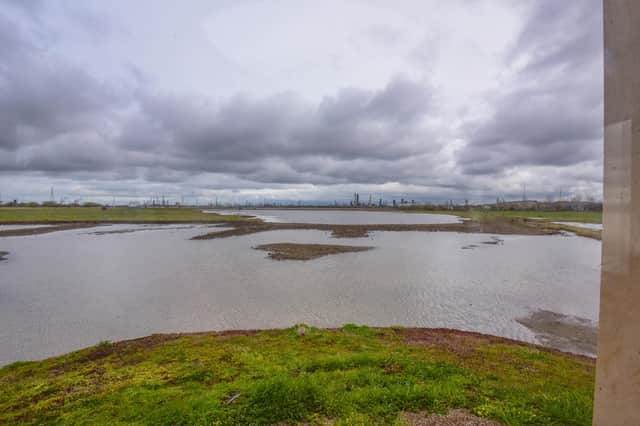Human skulls and Roman remains found on planned power plant site in Saltholme


Saltholme Power Limited has planning permission for two gas power stations off Cowpen Bewley Road, in Saltholme.
But an excavation on the site has uncovered at least two human burials and a high number of “late Roman artefacts” – which will need more analysis by archaeology experts.
Advertisement
Hide AdAdvertisement
Hide AdThe Archaeological Services team at Durham University carried out the fieldwork on behalf developers last year.
And a post-excavation survey urged “full analysis” of what was uncovered given it was a “significant archaeological resource”.
The report found one grave appeared to contain human infant remains and “two skulls buried side by side”.
Experts judged “poor preservation” meant little survived of the skeletons except for the skulls.
Advertisement
Hide AdAdvertisement
Hide AdThe report added: “A large assemblage of pot shards, animal bone, coins and other artefacts was recovered from the archaeological features – indicating that they are likely to date from the Roman period.”
The survey stated the findings indicated a series of enclosures with a Roman settlement – and agricultural activity over much of the site.
A very poorly preserved skeleton was also found encased in sun-baked clay at one of the digs.
At the time of the assessment, experts believed burials were “most likely” to date to the Roman period.
Advertisement
Hide AdAdvertisement
Hide AdPlanning permission for two 50 megawatt hubs was granted at the site in January 2019.
But there are a raft of conditions attached which require noise, ecology and archaeological surveys to be carried out.
The archaeological conditions cannot be discharged until a final report is approved by the Hartlepool-based Tees Archaeology service.
On the back of the findings, Stockton North MP Alex Cunningham said: “This is a fascinating discovery and I think the uncovering of ancient human remains certainly warrants further exploration of the site by the archaeological team.
Advertisement
Hide AdAdvertisement
Hide Ad“The early work suggests that there could be other items of interest that shed light on our local heritage yet to be uncovered – and I would like to see the team being given more time to carry out more surveys of the area.
“I hope the plans for the site could be paused to allow this work to happen.”
The bid for the two power plants has proved controversial at times – with a tangled web of planning applications submitted.
Dozens of objections were lodged by Cowpen Bewley residents – with concerns over noise, pollution and the nearby RSPB reserve.
Advertisement
Hide AdAdvertisement
Hide AdA noise assessment by the firm found it was “unlikely that any adverse impacts would occur” with impacts deemed “low to negligible”.
But the company withdrew its noise survey last summer – with campaigners claiming a temporary victory.
A spokesman for energy firm Statera Energy said the survey had been completed in accordance with what Stockton Council had asked for – adding analysis of the archaeological findings could be done off-site.
He also confirmed “enabling works” had started on the power plant site – and denied the archaeological findings would cause any delay.
Advertisement
Hide AdAdvertisement
Hide AdThe spokesman added: “There is no reason for any of the plans to change.
“There was nothing found that was considered significant enough to warrant that.”
According to a study by Tees Archaeology, the Romans seem to have had the North East and Yorkshire under control by the reign of Hadrian, which began in 117 AD.
Modern day Teesside was thought to have been occupied by a sub-section of the native Brigantes tribe.
Advertisement
Hide AdAdvertisement
Hide AdCatcote Village – a site with native roundhouses and Roman-style rectangular buildings – was uncovered in 1963 during development work on the playing fields behind English Martyrs School, in Hartlepool.